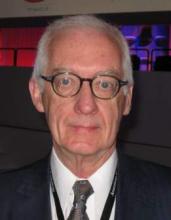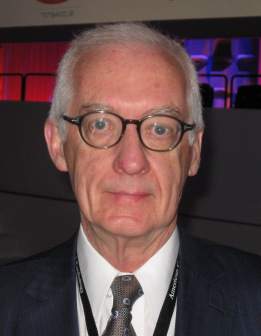User login
SNOWMASS, COLO. – Early feasibility trials of transcatheter mitral valve replacement in patients with significant functional mitral regurgitation have received Food and Drug Administration approval and are about to commence in the United States.
“This is deja vu all over again. This is TAVR [transcatheter aortic valve replacement] 10 years ago. And we’re about to see the same level of investment and enthusiasm in the mitral space that we saw in TAVR 10 years ago,” Dr. Michael J. Mack predicted at the Annual Cardiovascular Conference at Snowmass.
As a pioneer of TAVR in the United States, he knows very well what that looks like. While serving as president of the Society of Thoracic Surgeons, he forged an epic cross-specialty collaboration with then–ACC President Dr. David R. Holmes Jr. that led to creation of an unprecedented joint STS/ACC TAVR Registry and fostered the concept of the heart team approach.
Dr. Mack said that at present, there are five “very promising” devices for transcatheter mitral valve replacement (TMVR), four with human experience. Three of the five – the Edwards Fortis, Neovasc Tiara, and the Tendyne device – have received FDA approval for early human feasibility trials, to begin imminently.
“Eighteen of these procedures have been done worldwide, all in Europe or Paraguay. This is a new day at the FDA, and the FDA – with a worldwide experience of only 18 – is allowing three early feasibility trials of 15 patients each at three U.S. centers, starting immediately. By the end of the year there will be experience with 45 transcatheter mitral valve replacements in the United States,” observed Dr. Mack, medical director of Baylor Health Care System in Plano, Tex.
All three devices under evaluation will be placed via a transapical approach using a mini-thoracotomy. This has proved to be a much simpler delivery route than the transfemoral approach. The TMVR procedure relies heavily upon 3-D echocardiography and fluoroscopy.
“There’s now a very robust field of mitral valve imaging, just like we’ve seen over the last 10 years for the aortic valve,” Dr. Mack said. “We’re learning a lot about mitral valve anatomy and papillary muscle positioning that we didn’t know before. What we’ve learned from TAVR is all coming over to the mitral space.”
The rationale for TMVR is that the open surgical experience has shown recurrent mitral regurgitation is vastly more common after mitral valve repair than replacement.
Nevertheless, transcatheter mitral valve repair is already here, and its role may grow substantially. The MitraClip device received FDA approval in Fall 2013 for percutaneous repair of severely symptomatic primary degenerative mitral regurgitation in patients who have a reasonable life expectancy but prohibitive surgical risk due to comorbidities. The device is designed to clip the valve leaflets together without surgical suturing. Roughly 1,500 MitraClip procedures have been done to date in the United States, and the initial commercial experience will be presented as a late-breaker at the annual ACC meeting in San Diego in March.
Together with cardiologist Dr. Gregg W. Stone, Dr. Mack is co–principal investigator of the COAPT trial, in which the MitraClip is being studied as a treatment for significant functional or secondary mitral regurgitation, as opposed to the primary degenerative mitral regurgitation for which it’s already indicated. If this major clinical trial yields positive results, the role of the MitraClip will greatly expand.
The COAPT trial is sponsored by Abbott Vascular. Dr. Mack reported receiving research grants from Abbott and Edwards Lifesciences.
SNOWMASS, COLO. – Early feasibility trials of transcatheter mitral valve replacement in patients with significant functional mitral regurgitation have received Food and Drug Administration approval and are about to commence in the United States.
“This is deja vu all over again. This is TAVR [transcatheter aortic valve replacement] 10 years ago. And we’re about to see the same level of investment and enthusiasm in the mitral space that we saw in TAVR 10 years ago,” Dr. Michael J. Mack predicted at the Annual Cardiovascular Conference at Snowmass.
As a pioneer of TAVR in the United States, he knows very well what that looks like. While serving as president of the Society of Thoracic Surgeons, he forged an epic cross-specialty collaboration with then–ACC President Dr. David R. Holmes Jr. that led to creation of an unprecedented joint STS/ACC TAVR Registry and fostered the concept of the heart team approach.
Dr. Mack said that at present, there are five “very promising” devices for transcatheter mitral valve replacement (TMVR), four with human experience. Three of the five – the Edwards Fortis, Neovasc Tiara, and the Tendyne device – have received FDA approval for early human feasibility trials, to begin imminently.
“Eighteen of these procedures have been done worldwide, all in Europe or Paraguay. This is a new day at the FDA, and the FDA – with a worldwide experience of only 18 – is allowing three early feasibility trials of 15 patients each at three U.S. centers, starting immediately. By the end of the year there will be experience with 45 transcatheter mitral valve replacements in the United States,” observed Dr. Mack, medical director of Baylor Health Care System in Plano, Tex.
All three devices under evaluation will be placed via a transapical approach using a mini-thoracotomy. This has proved to be a much simpler delivery route than the transfemoral approach. The TMVR procedure relies heavily upon 3-D echocardiography and fluoroscopy.
“There’s now a very robust field of mitral valve imaging, just like we’ve seen over the last 10 years for the aortic valve,” Dr. Mack said. “We’re learning a lot about mitral valve anatomy and papillary muscle positioning that we didn’t know before. What we’ve learned from TAVR is all coming over to the mitral space.”
The rationale for TMVR is that the open surgical experience has shown recurrent mitral regurgitation is vastly more common after mitral valve repair than replacement.
Nevertheless, transcatheter mitral valve repair is already here, and its role may grow substantially. The MitraClip device received FDA approval in Fall 2013 for percutaneous repair of severely symptomatic primary degenerative mitral regurgitation in patients who have a reasonable life expectancy but prohibitive surgical risk due to comorbidities. The device is designed to clip the valve leaflets together without surgical suturing. Roughly 1,500 MitraClip procedures have been done to date in the United States, and the initial commercial experience will be presented as a late-breaker at the annual ACC meeting in San Diego in March.
Together with cardiologist Dr. Gregg W. Stone, Dr. Mack is co–principal investigator of the COAPT trial, in which the MitraClip is being studied as a treatment for significant functional or secondary mitral regurgitation, as opposed to the primary degenerative mitral regurgitation for which it’s already indicated. If this major clinical trial yields positive results, the role of the MitraClip will greatly expand.
The COAPT trial is sponsored by Abbott Vascular. Dr. Mack reported receiving research grants from Abbott and Edwards Lifesciences.
SNOWMASS, COLO. – Early feasibility trials of transcatheter mitral valve replacement in patients with significant functional mitral regurgitation have received Food and Drug Administration approval and are about to commence in the United States.
“This is deja vu all over again. This is TAVR [transcatheter aortic valve replacement] 10 years ago. And we’re about to see the same level of investment and enthusiasm in the mitral space that we saw in TAVR 10 years ago,” Dr. Michael J. Mack predicted at the Annual Cardiovascular Conference at Snowmass.
As a pioneer of TAVR in the United States, he knows very well what that looks like. While serving as president of the Society of Thoracic Surgeons, he forged an epic cross-specialty collaboration with then–ACC President Dr. David R. Holmes Jr. that led to creation of an unprecedented joint STS/ACC TAVR Registry and fostered the concept of the heart team approach.
Dr. Mack said that at present, there are five “very promising” devices for transcatheter mitral valve replacement (TMVR), four with human experience. Three of the five – the Edwards Fortis, Neovasc Tiara, and the Tendyne device – have received FDA approval for early human feasibility trials, to begin imminently.
“Eighteen of these procedures have been done worldwide, all in Europe or Paraguay. This is a new day at the FDA, and the FDA – with a worldwide experience of only 18 – is allowing three early feasibility trials of 15 patients each at three U.S. centers, starting immediately. By the end of the year there will be experience with 45 transcatheter mitral valve replacements in the United States,” observed Dr. Mack, medical director of Baylor Health Care System in Plano, Tex.
All three devices under evaluation will be placed via a transapical approach using a mini-thoracotomy. This has proved to be a much simpler delivery route than the transfemoral approach. The TMVR procedure relies heavily upon 3-D echocardiography and fluoroscopy.
“There’s now a very robust field of mitral valve imaging, just like we’ve seen over the last 10 years for the aortic valve,” Dr. Mack said. “We’re learning a lot about mitral valve anatomy and papillary muscle positioning that we didn’t know before. What we’ve learned from TAVR is all coming over to the mitral space.”
The rationale for TMVR is that the open surgical experience has shown recurrent mitral regurgitation is vastly more common after mitral valve repair than replacement.
Nevertheless, transcatheter mitral valve repair is already here, and its role may grow substantially. The MitraClip device received FDA approval in Fall 2013 for percutaneous repair of severely symptomatic primary degenerative mitral regurgitation in patients who have a reasonable life expectancy but prohibitive surgical risk due to comorbidities. The device is designed to clip the valve leaflets together without surgical suturing. Roughly 1,500 MitraClip procedures have been done to date in the United States, and the initial commercial experience will be presented as a late-breaker at the annual ACC meeting in San Diego in March.
Together with cardiologist Dr. Gregg W. Stone, Dr. Mack is co–principal investigator of the COAPT trial, in which the MitraClip is being studied as a treatment for significant functional or secondary mitral regurgitation, as opposed to the primary degenerative mitral regurgitation for which it’s already indicated. If this major clinical trial yields positive results, the role of the MitraClip will greatly expand.
The COAPT trial is sponsored by Abbott Vascular. Dr. Mack reported receiving research grants from Abbott and Edwards Lifesciences.
EXPERT ANALYSIS FROM THE CARDIOVASCULAR CONFERENCE AT SNOWMASS

